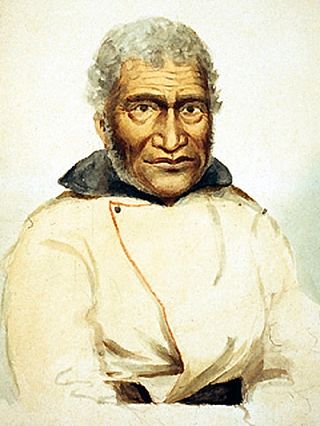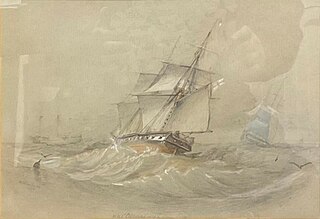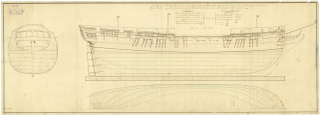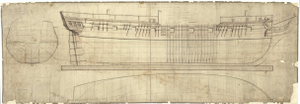
The first USS Essex of the United States Navy was a 36-gun or 32-gun sailing frigate that participated in the Quasi-War with France, the First Barbary War, and in the War of 1812. The British captured her in 1814 and she then served as HMS Essex until sold at public auction on 6 June 1837.

HMS Tonnant was an 80-gun ship of the line of the Royal Navy. She had previously been Tonnant of the French Navy and the lead ship of the Tonnant class. The British captured her in August 1793 during the Siege of Toulon but the French recaptured her when the siege was broken in December. Rear-Admiral Horatio Nelson captured her at Aboukir Bay off the coast of Egypt at the Battle of the Nile on 1 August 1798. She was taken into British service as HMS Tonnant. She went on to fight at the Battle of Trafalgar in 1805, during the Napoleonic Wars.

HMS Phoebe was a 36-gun fifth rate of the Royal Navy. She had a career of almost twenty years and fought in the French Revolutionary Wars, the Napoleonic Wars and the War of 1812. Overall, her crews were awarded six clasps to the Naval General Service Medals, with two taking place in the French Revolutionary Wars, three during the Napoleonic Wars and the sixth in the War of 1812. Three of the clasps carried the name Phoebe. During her career, Phoebe sailed to the Mediterranean and Baltic seas, the Indian Ocean, South East Asia, North and South America.

HMS Aetna was the mercantile Success launched in 1803 at Littlehampton. The Admiralty purchased her in 1803 for conversion into a Royal Navy bomb vessel. Aetna participated in the second Battle of Copenhagen in 1807 and the Battle of the Basque Roads in 1809. Later, she participated in the attack on Fort McHenry in the Battle of Baltimore and the bombardment of Fort Washington, Maryland in 1814, during the War of 1812. The Navy sold her in 1816 and she returned to mercantile service under her original name. She sailed to Calcutta, to Rio de Janeiro, and more locally until she was wrecked in 1823.
HMS Heron was originally the merchant vessel Jason, launched at Newcastle in 1803, that the Admiralty purchased in 1804 for the Royal Navy for use as 16-gun ship-sloop under the name HMS Heron. During the Napoleonic Wars she served as a convoy escort on the Leeward Islands station. Then in 1810 the Admiralty had her converted into a bomb vessel and renamed her HMS Volcano. As Volcano she served during the War of 1812, and in particular participated in the Battle of Baltimore. The Admiralty sold her in 1816. New owners returned her to mercantile service under her original name of Jason. She was wrecked in 1821.

The Columbia District was a fur trading district in the Pacific Northwest region of British North America in the 19th century. Much of its territory overlapped with the disputed Oregon Country. It was explored by the North West Company between 1793 and 1811, and established as an operating fur district around 1810. The North West Company was absorbed into the Hudson's Bay Company in 1821 under which the Columbia District became known as the Columbia Department. The Oregon Treaty of 1846 marked the effective end of the Hudson's Bay Company's Columbia Department.

The Battle of Valparaíso, also called the Capture of USS Essex, was a naval action fought during the War of 1812. It took place off Valparaíso, Chile on March 28, 1814, between the frigate USS Essex and the sloop USS Essex Junior of the United States Navy and the frigate HMS Phoebe and sloop HMS Cherub of the Royal Navy. The British ships won the battle, and the American vessels were captured.

HMS Cherub was an 18-gun Royal Navy Cormorant-class sloop built in Dover in 1806. She participated in two major campaigns in the West Indies during the Napoleonic Wars, and one major engagement in the Pacific during the War of 1812, all each of which earned her crews clasps to the Naval General Service Medal. The Navy sold her in 1820.

Naukane, also known as John Coxe, Edward Cox, and Coxe was a Native Hawaiian chief who traveled widely through North America in the early 19th century. He was either considered a member of the royal household of Kamehameha I or a chiefly retainer, possibly the same person as Noukana, the son of High Chief Kamanawa, the King's uncle and trusted advisor.
HMS Cydnus was one of eight Royal Navy 38-gun Cydnus-class fifth-rates. This frigate was built in 1813 at Blackwall Yard, London, and broken up in 1816.

Prévoyante was the second of two flûtes built to a design by Raymond-Antoine Haran. She was launched in May 1793 at Bayonne. The British frigates HMS Thetis and HMS Hussar captured Prévoyante in 1795 and the British took her into the Royal Navy after first converting her to a fifth rate. She served as a frigate until 1800, when she underwent reconversion back to a store ship. As a store ship she sailed to the Mediterranean, Cape of Good Hope, and Quebec. She was sold for breaking up in July 1819.

HMS Julia was a British Royal Navy 16-gun brig-sloop of the Seagull class launched in February 1806. After a fairly uneventful decade-long career she was wrecked at Tristan da Cunha in 1817 with heavy loss of life.

HMS Carron was a 20-gun Cyrus-class sixth-rate post ship of the Royal Navy built in 1813 by Edward Adams, at Bucklers Hard in Hampshire. She was wrecked in 1820.

HMS Childers was a Royal Navy 18-gun Cruizer-class brig-sloop that Nicholas Diddams built at Portsmouth Dockyard and launched in 1812. She was broken up in 1822.

HMS Briton was a 38-gun fifth-rate frigate of the British Royal Navy's Leda class. She was ordered on 28 September 1808 and her keel laid down at Chatham Dockyard in February 1810. Navy veteran Sir Thomas Staines was appointed her first captain on 7 May 1812 but did not join the ship until 17 June 1813 owing to his being at sea aboard HMS Hamadryad. After a period of cruising in the Bay of Biscay, the vessel set sail for South America where during the course of several missions she unexpectedly encountered the last member of the crew that had seized HMS Bounty from its captain Lieutenant William Bligh during the 1789 mutiny aboard the ship. With the coming of the Pax Britannica in 1815, Briton undertook various voyages before she was broken up in 1860.
Éole was an 18-gun corvette of the French Navy, launched, captured, and later commissioned in the Royal Navy in 1799 as HMS Nimrod after her capture by HMS Solebay. She was then "the finest and most handsome ship-sloop in the British navy". She was sold in 1811. Nimrod made three whaling voyages between 1811 and 1819. On her first she captured several American whalers. Nimrod was last listed in 1820.
Isaac Todd was built at Québec in 1811 for John McTavish, a partner in the North West Company (NWC). Her mission was to wrest Fort Astoria, at the mouth of the Columbia River, from the American Pacific Fur Company, and thereby destroy the American competition in the fur trade on the Northwest Coast. By the time she arrived there the NWC had purchased the fort, which it renamed Fort George. Isaac Todd then sailed to China where she picked up a cargo of tea for the British East India Company (EIC). She was wrecked in 1821 while carrying cargo and passengers from London to Québec.

HMS Comet was launched in 1807 as a Thais-class fireship of the Royal Navy. In 1808 the class were re-rated as sloops, and in 1811 they were re-rated as 20-gun sixth rates. Comet participated in one action that resulted in her crew being awarded the Naval General Service Medal, and some other actions and captures. The Navy sold her in 1815. In 1816 she became an East Indiaman, sailing under a license from the British East India Company (EIC). She sailed between the United Kingdom and Ceylon. It was on one of these journeys that she was wrecked on Cole House Point on the River Thames on 9 August 1828.

The Thames-class frigate was a 32-gun fifth-rate frigate class of eight ships of the Royal Navy based on the Richmond-class frigate designed by William Bately. The ships were ordered to the older design, which was of a smaller type of ship compared to more modern designs, so that they could be built quickly and cheaply in time to assist in defending against Napoleon's expected invasion of Britain. The class received several design changes to the Richmond class, being built of fir instead of oak, with these changes making the class generally slower and less weatherly than their predecessors, especially when in heavy weather conditions. The first two ships of the class, Pallas and Circe, were ordered on 16 March 1804 with two more ordered on 1 May and the final four on 12 July. The final ship of the class, Medea, was cancelled on 22 October before construction could begin but the other seven ships of the class were commissioned between 1804 and 1806.
HMS Thames was a 32-gun fifth-rate Thames-class frigate of the Royal Navy, launched in 1805 at Chatham.















